Physical Address
304 North Cardinal St.
Dorchester Center, MA 02124
A gross placental examination is important as a means of documenting structural abnormalities of the placenta and as a guide for tissue selection for histology. Many structural abnormalities were classified as significant placental disorders by the 1959–1966 Collaborative Perinatal Study, a large prospective study that evaluated relationships between placental pathology and mental, neurologic, or psychological disturbances in childhood ( Table 31.1 ).
| Placental Abnormality | Abnormal Outcome |
|---|---|
| Short umbilical cord | MR, neuro, CP |
| Single umbilical artery | MR, neuro |
| Velamentous cord insertion | Psych |
| Green-colored umbilical cord (suggestive of meconium) | Psych |
| Long umbilical cord | Psych |
| Opaque fetal surface (suggestive of chorioamnionitis) | MR, neuro, Sz |
| Circumvallate membrane insertion | Neuro |
| Meconium-stained amniotic fluid | CP, MR, Sz |
| Absent subchorionic fibrin | MR, neuro, CP |
| Succenturiate lobe | MR, Sz |
| Maternal floor infarct | MR, neuro |
| Bipartite/tripartite shape | MR, neuro, psych |
| Diffuse chorionic fibrin | Psych, neuro |
a Associated with abnormal childhood mental, neurologic, or psychological outcome.
From these findings have arisen plausible pathogenetic mechanisms for some placental structural abnormalities and their related outcomes. For example, prolonged fetal inactivity, predictive of subsequent neurologic disease or mental handicap, may be associated with a short umbilical cord and absent subchorionic fibrin ; conversely, excessive fetal movement (predictive of subsequent childhood hyperactivity) may be associated with an abnormally long umbilical cord and increased subchorionic fibrin. For many gross placental lesions listed in Table 31.1 , however, the relationship between a placental structural abnormality and adverse outcome is obscure; for example, it is intuitively unclear why a bipartite (bilobate) placenta should be associated with a subsequent psychological disturbance (more specifically, fearful, apprehensive, inflexible, or hostile behavior).
From a practical viewpoint, gross placental examination is important for two reasons: (1) placental gross abnormalities may provide clinicopathologic correlations with obstetric events (e.g., very small placental size and infarcts strongly suggest chronic placental ischemia resulting from maternal vascular malperfusion, whereas ruptured membranous vessels may explain fetal death or neonatal anemia); and (2) gross placental abnormalities represent placental regions that should be studied further histologically (e.g., infarcts, depressions). In recent decades, attention has been more focused on the clinical significance of microscopic lesions because these are more specific and sensitive as indicators of suboptimal intrauterine processes potentially associated with an untoward fetal or neonatal outcome (see later, “Microscopic Examination of the Placenta ”). As noted above, gross placental abnormalities may be associated with, and therefore be supportive of, a constellation of microscopic findings within specific clinical contexts and therefore remain useful features to recognize, describe, sample, and incorporate into pathologic diagnoses. However, the era of strict reliance on gross placental pathology has passed.
More recent studies on suggested placental sampling and definitional criteria of select placental lesions have been published.
Some authors have stated that every placenta should be pathologically examined, at least grossly ; others have noted that a minimum of 10% to 15% of placentas should be examined. Currently, at the Brigham and Women's Hospital, approximately 20% of placentas are selected by obstetricians for pathologic examination. The most common indications for placental examination at the Brigham and Women's Hospital include the following: (1) preterm delivery; (2) multifetal gestations; (3) clinical chorioamnionitis; (4) fetal death; (5) maternal diseases such as preeclampsia and diabetes; (6) fetal abnormalities, ranging from malformations and growth restriction to clinical fetal distress; (7) third-trimester bleeding; and (8) gross placental abnormalities, including a single umbilical artery, abnormal cord insertion, cord knots, and placental masses.
Since the 1990s, medicolegal implications of placental pathologic examination have assumed heightened prominence. In obstetric malpractice litigation involving perinatal death, neurologic damage, or mental impairment, the presence of nonacute placental abnormalities (e.g., infarcts, small placental size, membranous cord insertion, decidual arteriopathy, chorangiosis) has suggested that a suboptimal intrauterine environment may have preceded the peripartum period. One analysis of obstetric malpractice claims has concluded that “many more neurologically impaired infant claims could be successfully defended if placenta specimens were available for evaluation at the time a claim is made.”
Comprehensive guidelines for placental selection published by the College of American Pathologists are summarized in Box 31.1 . These include circumstances indicating maternal or fetal pathology, visible placental anomalies, or other historic events that warrant placental examination (see Table 31.1 ).
Maternal conditions
Diabetes
Hypertension
Prior reproductive failure (e.g., one or more spontaneous abortions, stillbirths, neonatal deaths, premature births)
Maternal substance abuse
Prematurity or postmaturity
Peripartum conditions
Fever
Suspected or proven infection
Bleeding
Suspected abruptio placentae
Fetal and neonatal conditions
Stillbirth or perinatal death
Multiple births
Congenital anomalies
Fetal growth restriction
Hydrops
Meconium
Neonatal intensive care unit (NICU) admission
Apgar score < 3 at 5 min
Neurologic problems, including seizures
Suspected infection
Oligohydramnios
Gross placental anomalies
Other (abnormal delivery, infant, medicolegal concerns)
An increasing issue with respect to placental retention in hospitals is the request for placentas to be released to families following delivery. At Brigham and Women's Hospital, we allow placental release only after the following conditions are met: (1) no maternal, fetal, neonatal, or placental indications for pathologic evaluation; (2) no receipt, even if inadvertently, in the pathology laboratory, which is considered a contaminated area; and (3) appropriate release forms signed by the family. We suggest that institutions be aware of this trend and prepare their own policies for placental release.
The placenta is optimally examined in the fresh state—with prompt refrigeration, specimens can be stored for up to 1 week or longer without interfering with adequate evaluation. However, many institutions use formalin fixation before pathologic examination. Fig. 31.1 summarizes the steps in a routine singleton placental examination. After gross inspection, a short segment of umbilical cord, including any abnormal regions, and a jelly roll of the membranes, wrapped around a portion of the marginal placenta, are fixed in 10% formalin; in cases of suspected maternal vascular disease (e.g., hypertension, diabetes, systemic lupus, fetal growth restriction), two membrane rolls are prepared to enhance the capture of decidual arteriopathy.
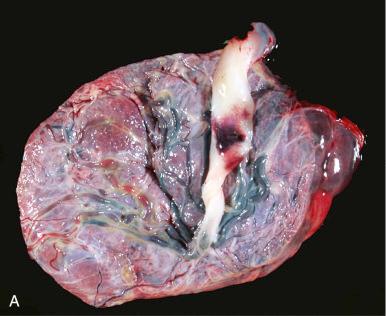
The remaining membranes and cord are then trimmed from the placental disc, and the disc is weighed. Next, with the maternal surface of the placenta facing up, the parenchyma is serially sectioned at 1-cm intervals; two full-thickness cubes of normal parenchyma (2–3 cm 2 ) and representative blocks of lesions (e.g., infarcts, intervillous thrombi, chorangiomas) are fixed in formalin overnight before processing and routine staining. One or two slides of normal disc parenchyma and adnexa—two umbilical cord sections, one each from the fetal and placental poles, and one or two membrane rolls—and additional samples of grossly abnormal areas are assessed histologically ( Fig. 31.2 ). Separated twin placentas are handled exactly like singleton placentas. Additional details concerning fused twin placentas are discussed later in this chapter.
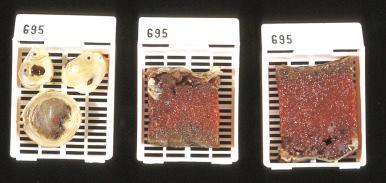
Bacteriologic cultures need not be performed routinely, even when chorioamnionitis is suspected. However, if a particular pathogen (e.g., group B streptococcus, Listeria ) is of special clinical interest, a culture may be taken from the (sterile) chorionic surface after carefully peeling away the amnion covering the fetal surface of the placental disc. Viral cultures from sterile villous tissue occasionally yield important information when a fetal viral infection is strongly suspected from the history or neonatal examination. However, if not selected judiciously, viral cultures will not usually be fruitful. Moreover, immunohistochemistry and molecular assays have been sufficiently developed to permit detection of these pathogens in fixed tissues and, for most organisms, have supplanted the need for viral cultures, including for unexplained fetal death.
A placental karyotype is indicated in cases of recurrent spontaneous abortion. Placental karyotypes are also useful when chromosomal abnormalities are suspected in macerated stillborn fetuses. In these circumstances, although autolyzed fetal tissues will not grow in tissue culture, villous tissues can often be readily cultured and karyotyped because the placental villi remain nourished by maternal blood after fetal death. Karyotypes are performed on sterilely dissected villous tissue (disposable suture removal sets work well) and placed into Hanks' balanced salt solution, which can be refrigerated for storage but never should be frozen.
Two caveats regarding placental karyotypes should be noted: (1) a karyotype revealing a 46,XX genotype may reflect contamination by maternal tissues; and (2) rarely, the placental karyotype may differ from that of the fetus (e.g., confined placental mosaicism).
Photography of any suspicious gross placental abnormality is always recommended for documentation and correlation with histology.
Variations in placental shape can occur related to an unusual uterine shape, nonuniform uteroplacental perfusion, or incomplete regression of membranous villi. These shape variations include bilobation—two roughly equal placental hemidiscs ( Fig. 31.3 ), either marginally fused or entirely separated but connected by membranous fetal vessels—trilobation, accessory or succenturiate lobation (smaller islands of placental tissue connected by membranous vessels; Fig. 31.4 ), and, rarely, placenta membranacea (a spherical placenta because of near-total persistence of membranous villi). Although the Collaborative Perinatal Study has suggested that some of these abnormal placental shapes may be associated with adverse outcomes (see Table 31.1 ), little literature exists in this area, and most general placental texts have minimized the significance of these aberrant placental shapes. Of note, however, oddly shaped placentas are often associated with unprotected membranous fetal vessels, and these vessels should be carefully examined for thromboses or evidence of rupture. When membranous vessels are identified adjacent to the site of membrane rupture in a spontaneously delivered placenta, this finding should prompt consideration of vasa previa, defined as membranous fetal vessels traversing the internal cervical os in vivo.
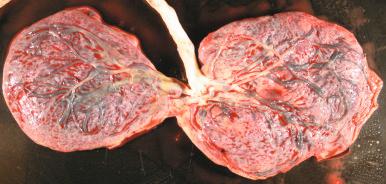
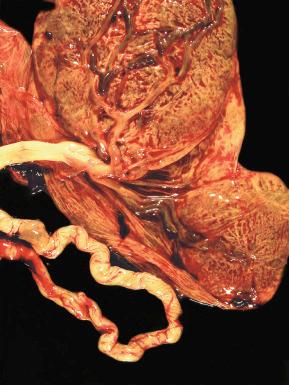
Placentas should be weighed after removal of the umbilical cord, membranes, and any attached maternal blood clot. Abnormally small placentas are usually associated with maternal vascular malperfusion and fetal growth restriction secondary to maternal disorders associated with vascular disease. Other conditions that may be causally related to growth-restricted placentas are listed in Box 31.2 . Excessively heavy placentas may signify maternal diabetes, placental hydrops in the setting of fetal hydrops, or congenital syphilis, among other conditions. Placental weights above the 90th or below the 10th percentile for gestational age should be noted in the pathology report because an abnormal placental weight may be associated with other clinical and pathologic findings of potential maternal, fetal, or neonatal significance.
Maternal vascular malperfusion (e.g., preeclampsia)
Fetal growth restriction
Chromosomal disorders (particularly trisomy 18)
Congenital malformations
Abnormal neurologic outcome (e.g., cerebral palsy)
Multifetal gestations
Maternal diabetes
Fetal hydrops
Congenital syphilis
Villous edema
Chorangiosis
Mesenchymal dysplasia
The membranes and fetal surface of the placenta are normally colorless, glistening, and transparent. In a normal placenta, chorionic vessels can be readily visualized radiating centrifugally from the umbilical cord insertion ( Fig. 31.5 ). A dull, off-white to tan to green opaque appearance can signal acute chorioamnionitis due to membrane infiltration by acute inflammatory cells, in which case the underlying chorionic vasculature is obscured ( Fig. 31.6 ). This appearance is more common in preterm placentas, particularly with prolonged preterm rupture of the membranes. In addition to the dull or opaque appearance, the placenta in chorioamnionitis may emit a foul odor. Benirschke and Kaufmann have described a characteristic fetid smell with Escherichia coli infection and a sweet smell with listerial infection. Brown discoloration of the membranes and chorionic plate may be due to hemosiderin deposition secondary to chronic abruptio placentae or may reflect old meconium.
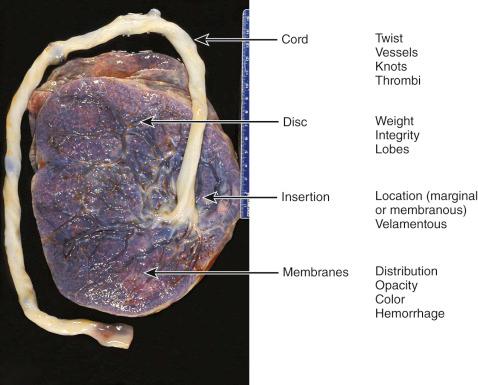
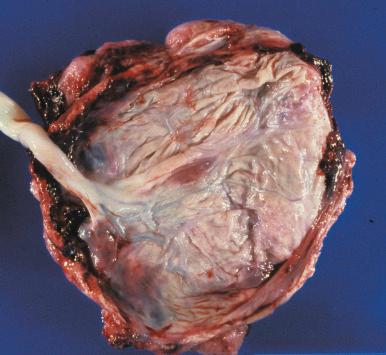
With chronic abruption, the brown discoloration develops because marginal retroplacental, subchorionic, and/or retromembranous blood enters the amniotic fluid (so-called port wine fluid), seeps through the extraplacental and/or chorionic membranes, and is picked up by chorion macrophages (discussed later). A diffluent (slimy) texture with green discoloration suggests meconium staining, a finding most common in term or post-term placentas. Green meconium staining begins at 1 to 2 hours and is maximal by 3 to 6 hours after meconium exposure ( Fig. 31.7 ). Prolonged meconium exposure of many hours' to days' duration leads to the aforementioned green-brown to brown discoloration and can result in tissue necrosis, with linear fissures and ulceration of the umbilical cord and microscopic myonecrosis of umbilical and/or chorionic vessels. It has been estimated to take a minimum of 12 to 16 hours for this myonecrosis to develop. When prolonged or thick meconium discharge is suspected, extra sampling of the umbilical cord and chorionic plate is indicated to look for such meconium-induced vascular necrosis (discussed later).

These are general principles of coloration and cause. Not all chorioamnionitis produce membrane opacity or discoloration and, as noted above, brown discoloration can indicate old meconium, and green discoloration can be seen with chorioamnionitis. Microscopic correlation is necessary.
The umbilical cord should be severed at the insertion to the placental disc, and the following should be recorded.
Marginal or battledore insertion ( Fig. 31.8A ) describes cord insertion within 1 cm of the placental disc edge; it is seen in approximately 5% of placentas. Membranous or velamentous insertion (see Fig. 31.8B ) refers to cord insertion onto the extraplacental membranes; it is seen in approximately 1% of placentas. Furcate insertion, which is least common, occurs when umbilical vessels branch before reaching the chorionic plate. Normal umbilical cords are central, paracentral, or eccentric; their relative sites of insertion are self-explanatory.
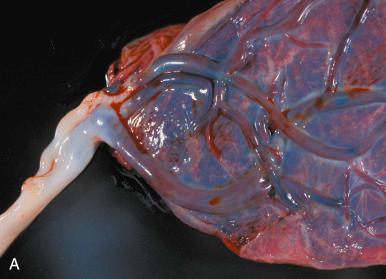
Membranous, also known as velamentous, vessels are encountered in about 1% of placentas. Rarely, these vessels rupture antenatally, leading to rapid fetal exsanguination, especially when located within the membranes covering the endocervical os (vasa previa). All membranous vessels should be described as intact or disrupted and given a maximum intramembranous length.
Hypocoiled umbilical cords (untwisted vessels, <1 coil/10 cm) in later gestation suggests prolonged fetal hypoactivity (e.g., muscular disorder, fetal entrapment; Fig. 31.9 ). Hypercoiled umbilical cords (>3 coils/10 cm) are associated with increased intrauterine activity. Due to excessive torqueing and localized kinking, hypercoiled cords are a predisposing condition for fetal vascular flow restriction, particularly with segmented and linked hypercoiling. Normally coiled umbilical cords (1 to 3 coils/10 cm, right or left twisted) fall between abnormal coiling indices.
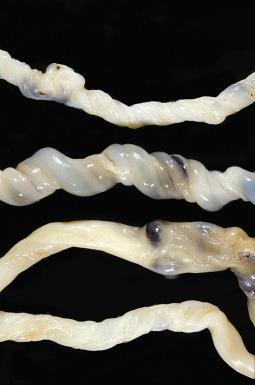
It is important to remember that umbilical cord lengths recorded in the laboratory are variably incomplete unless the portion of cord attached to the fetus, submitted for ancillary testing or discarded, is also measured. If the entire length is assessed and correlated with gestational age, a short umbilical cord (<40 cm at term) is associated with prolonged fetal inactivity and may prohibit adequate umbilical blood flow during fetal descent as cord vessels are stretched and their lumens thinned. An excessively long cord (>80 cm at term) predisposes to an untoward fetal or neonatal outcome, due predominantly to cord entanglement, with resulting fetal flow restriction. There is a positive correlation between umbilical cord length and coiling.
Glistening white or tan-white is normal. Innumerable pinpoint white spots (typically <1 mm in diameter) representing superficial microabscesses suggest fungal (almost always candidal) amniotic fluid infection ( Fig. 31.10A ), yellow-green suggests meconium exposure (for at least many hours before birth), and a diffuse brown-red discoloration due to hemolysis (see Fig. 31.10B ) suggests fetal retention of at least several hours after fetal death or, rarely, can be due to prolonged meconium discharge.
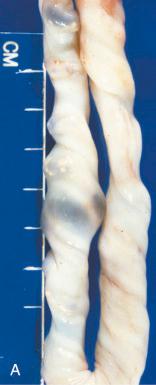
Red-brown discoloration may incorrectly be referred to as thrombosis by health care providers at stillbirth delivery. Correlation with clinical observations indicating an increased risk of fetal flow restriction, as well as downstream (placental disc) correlates of fetal malperfusion, can usually resolve the ambiguity.
So-called false knots or varices (see Fig. 31.10C ) are commonly seen and reflect vascular ectasia or tortuosity within the cord; these are rarely of clinical significance. True knots (see Fig. 31.10B ) are much less common and may be incidental insignificant findings if the knot is loose, or may cause fetal death if tight enough to restrict umbilical blood flow fatally. Even when lethal, they usually do not demonstrate confirmatory histologic findings at the site of the knot—thrombosis, interstitial hemorrhage, or inflammation—although fetal vascular thrombosis may be identified in downstream chorionic or stem villous tributary vessels.
A single umbilical artery is present in about 1% of placentas. There is an association with fetal disorders and syndromes, including malformations, aneuploidy, and demise. However, in most cases, a single umbilical artery is an isolated finding of no clinical significance.
This includes the exclusion of thrombi ( Fig. 31.11A and B ).
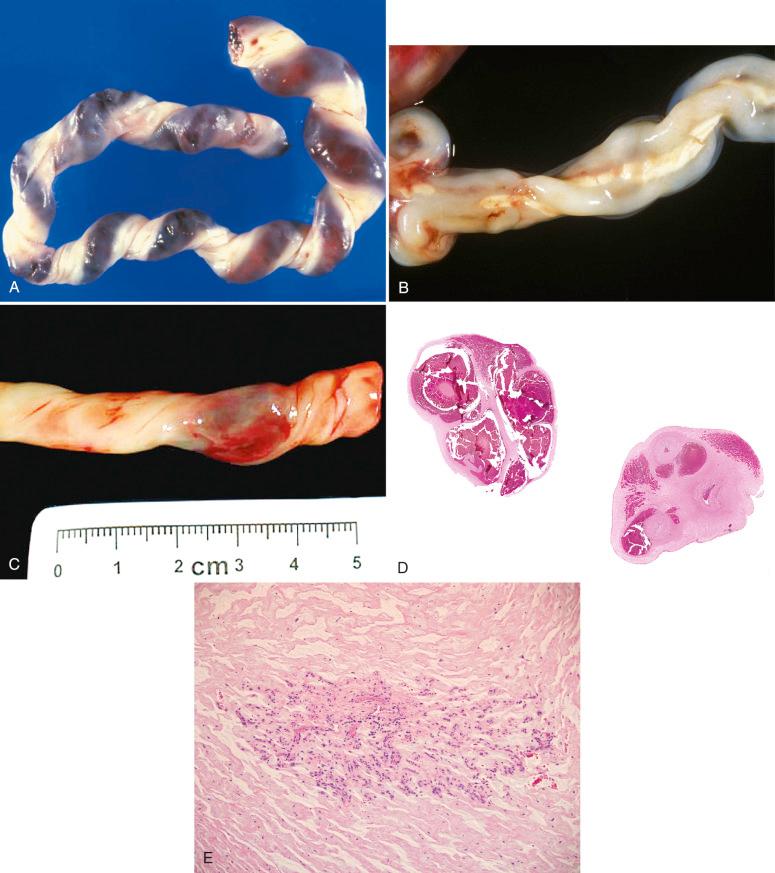
Cord trauma is common during placental delivery because of cord traction or umbilical clamping and is seen as blood concentrically arranged around cord vessel(s). Such changes should be viewed as an incidental inding unless the following is noted: (1) there is a clear history of a cord lesion prior to manipulation; (2) the hematoma is several centimeters in size; or (3) microscopic examination reveals degenerating red cells, with or without blood breakdown pigment. Spontaneous umbilical hematoma, a rare cause of fetal morbidity and mortality, may present as a dissecting hemorrhage, with luminal collapse and splitting of the vascular wall (see Fig. 31.11C and D ), suggesting combined mechanisms of cord compression and altered vascular tone in utero. To ascribe physiologic significance to the observation of purported spontaneous umbilical hematoma, ancillary supportive clinical findings (e.g., sudden fetal monitoring deterioration) and/or pathologic findings, including gross recordings of cord hematoma length and width, as well as microscopic evidence of antepartum evolution (e.g., surrounding myocyte ischemic necrosis, platelet or fibrin aggregation, with or without adherence, neutrophil chemotaxis, presumptively to tissue damage), need to be used.
Rarely, so-called hemangiomas of the cord have been described. In most cases, such as depicted in Fig. 31.11E , the vascular proliferation is of no clinical consequence.
The membranes should be examined with the following in mind.
This includes circummarginate and circumvallate insertions ( Fig. 31.12A and B ). Circumvallate membrane insertion, particularly when circumferential, is associated with chronic abruption.
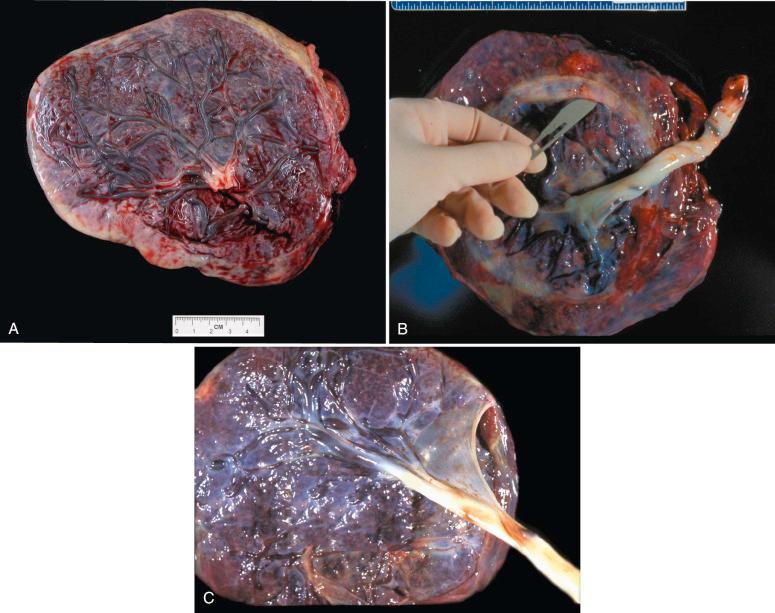
If the amnion is absent, tethered around the cord, or present as conspicuous webs (see Fig. 31.12C ), this may reflect early amnion rupture (amniotic band sequence), often with destructive, asymmetric fetal somatic transection defects. The chorionic surface should be sampled to look for vernix or vellus hair nodules (chorion nodosum) directly apposed to a reactive-appearing chorionic surface; the latter results from long-standing stromal exposure to amniotic fluid.
These features usually parallel that seen on the surface of the disc (see earlier, “General Appearance: Color ”).
A foul odor may reflect amniotic fluid infection.
The shiny transparent amnion is normally loosely adherent to the chorion of the placental disc. Branching radially from the umbilical cord insertion site, the fetal surface or chorionic vessels are arranged so that arteries are superficial to (cross over) veins. Beneath the chorionic plate, patches of subchorionic fibrin are commonly visualized as firm, tan-white regions.
Thrombosis of chorionic vessels can affect arteries or veins; a distended vessel that is firm in the unfixed state suggests fresh thrombosis; a collapsed, tan-white or yellow, fibrosed or calcified vessel suggests remote thrombosis.
Cysts of the placental surface include single or sometimes multiple thin-walled amniotic cysts or thicker-walled chorionic cysts; both are almost always incidental findings ( Fig. 31.13 ).
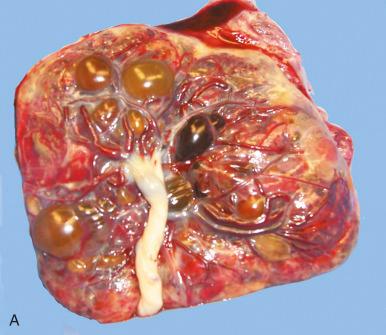
Tiny off-white nodular lesions on the chorionic surface may represent amnion nodosum (nodules of fetal vernix adherent to the amniotic surface because of severe prolonged oligohydramnios) ( Fig. 31.14 ) or (2) incidental squamous metaplasia (small plaques, usually localized to the region of cord insertion). Amnion nodosum can be grossly differentiated from squamous metaplasia in that nodules of amnion nodosum can be rubbed off the placental surface, whereas squamous metaplasia cannot.

These include the following.
These are placental capillary hemangiomas. On cross section, chorangiomas are well circumscribed and round, with a smooth, glistening, tan/red, myxoid consistency ( Fig. 31.15A ). Chorangiomas can have a uniformly dark red appearance, grossly resembling blood clot if engorged, or can be tan if bloodless. Because chorangiomas originate from the chorionic plate or stem villi, they are usually located subjacent to the chorionic surface; in contrast, infarcts are usually basally oriented. Both lesions, however, may be centrally located.
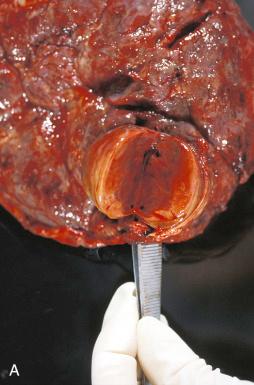
When present, one or more of these structures are located within the extraplacental membranes adjacent to the placental margin and consist of flattened, pale amorphous ellipses, often with visible retinal pigment or skeletal structures, particularly ribs (see Fig. 31.15B ).
This is a nodular mass of subchorionic fibrin, often with a laminated appearance on cross section. A large subchorionic hematoma (so-called Breus' mole) (see Fig. 31.15C ) may result from rupture of a fetal stem villous vessel, or may be due to intervillous blood coagulation due to maternal hypercoagulability; both causes are highly associated with stillbirth.
Very premature placentas have little subchorionic fibrin, which accumulates as gestational age increases. Naeye has hypothesized that subchorionic fibrin accumulates from placental trauma resulting from normal fetal movement and further suggested that the absence of subchorionic fibrin at term may indicate a long-standing decrease in fetal mobility, possibly reflecting a long-standing fetal neurologic impairment. In practice, evaluation of subchorionic fibrin is rarely of clinical significance.
The maternal surface of the placenta has a mosaic appearance that is comprised of 10 to 40 cotyledons. Each cotyledon has a slightly convex surface and is supported by one or more fetal stem villi ( Fig. 31.16 ). This mosaic pattern is focally or diffusely absent when there is maternal floor infarction, which obliterates the separation between cotyledons due to extensive fibrin deposition within the decidua and basal placenta.

When the placenta separates from the decidua after birth, “lacerations” of the maternal surface may develop, usually located between cotyledons. Such localized fragmentation may suggest that the placenta is incomplete. This issue can usually be resolved by gently molding the placenta back into its original shape; if placental tissue is truly missing, obvious gaps in the maternal surface will appear.
True fragmentation of the placenta is often evident following manual removal of the placenta ( Fig. 31.17 ). This raises the possibility that additional placental tissue may be retained, either because of incomplete placental removal or because of placenta creta. A diagnosis of placenta creta is supported by histologic assessment of myometrial fibers adherent to the basal plate, a result of deficient or absent intervening decidua (see Figs. 36.9 through 36.13 in Chapter 36; see Chapter 33 for details).
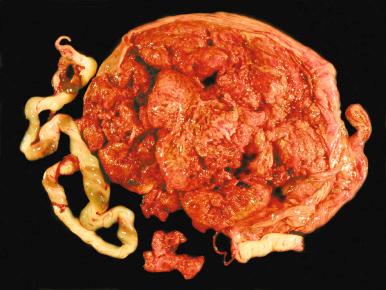
In many placentas, adherent fresh blood clot is present on the maternal surface; when this fresh clot is readily removed, the adjacent maternal surface is unremarkable ( Fig. 31.18 ). With abruptio placentae, an adherent, sometimes grossly laminated blood clot is found ( Fig. 31.19A ). Sometimes the clot destructively dissects into the placental disc, resulting in space-occupying intervillous hemorrhage. Blood clots of a remote abruptio placenta become laminated, consolidated, and eventually turn brown. The placenta adjacent to the adherent blood clot may be dark red due to (1) villous hemorrhage, an early hemorrhagic infarction, (2) compressed and concave due to both collapse of the intervillous space and to the space-occupying effect of the hematoma (see Fig. 31.19B ), or (3) firm and pale, indicating an infarct of at least several days' duration ( Fig. 31.20 ).
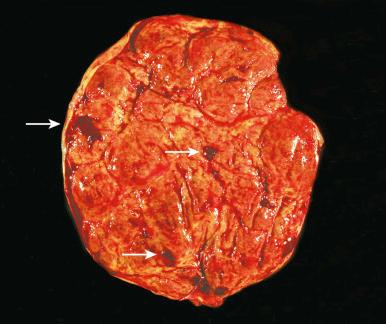

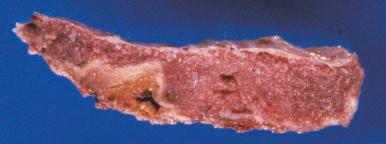
Placental abruption occurring shortly before delivery may not have time to manifest pathologic changes; this is an important conceptual point that supports a strong clinical impression of acute abruptio.
At term, the typical cut surface of the placenta has a burgundy color, a spongy consistency, and a thickness of 1.5 to 3 cm. On cross section, the following normal gross findings are evident: stem villi; small areas of tan/shiny fibrin (perivillous fibrin or septae); and laminated, subchorionic fibrin (rare in preterm placentas, common at term; Fig. 31.21 ).
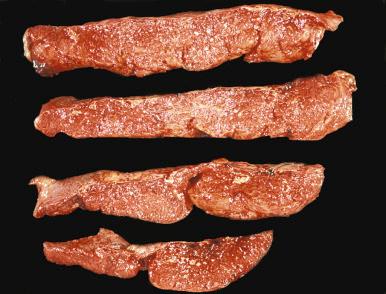
A diffusely thin placenta suggests marked prematurity or poor placental growth because of chronic maternal vascular malperfusion. Localized placental thinning may result from a remote infarct, a retroplacental leiomyoma or hematoma, or incomplete removal of the placenta. Increased thickness is associated with placentomegaly from hydrops fetalis, maternal diabetes, or congenital syphilis, among other conditions.
A diffuse, dark red color usually indicates congestion of fetal capillaries, a nonspecific finding. Less commonly, it may indicate diffuse fetal capillary proliferation (chorangiosis), an abnormality associated with maternal diabetes. A localized dark red area usually indicates an early infarct or a region of intravillous hemorrhage; the latter is commonly the result of abruptio placentae or placental trauma following manual extraction. A diffuse pallor may indicate remote fetal death (>1–2 weeks before birth), with diffuse villous fibrosis ( Fig. 31.22 ), edema from hydrops fetalis, or marked fetal anemia from any cause. Stillbirth from fetal exsanguination related to massive fetal-maternal hemorrhage may be suggested by placental and fetal pallor and can be documented and quantified by a maternal Kleihauer-Betke test. In a minority of cases, the location of the fetal-maternal hemorrhage will be seen as a fresh intervillous thrombus ( Fig. 31.23 ). Localized pallor usually indicates intervillous fibrin, infarction, or, rarely, regional avascular villi resulting from remote fetal thrombosis.
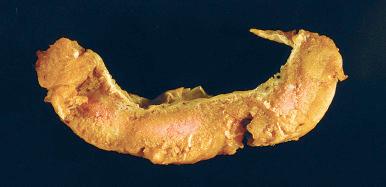
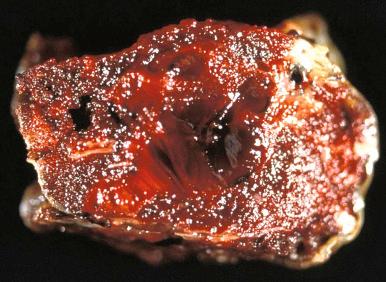
These are best recognized by their firm consistency, which is related to their villous composition. Infarcts are commonly wedge-shaped and located close to the maternal surface, reflecting their pathogenesis in the cessation of blood flow from servicing spiral arterioles. Although one or a few small basal or peripheral infarcts are not uncommon at term, central and full-thickness infarcts are always pathologic, as are placentas with multiple infarcts, especially of varying ages. Recent infarcts are dark red; older infarcts gradually change from brown-red to tan and finally to a yellow-white color. The entire sequence takes days to weeks to evolve ( Fig. 31.24 ). It is important to record the maximum size of infarcts as well as the approximate total percentage of placental parenchyma involved by infarction. Representative infarcts should always be sampled histologically to confirm the gross impression because, for example, primary placental choriocarcinoma is often described as grossly resembling placental infarction.
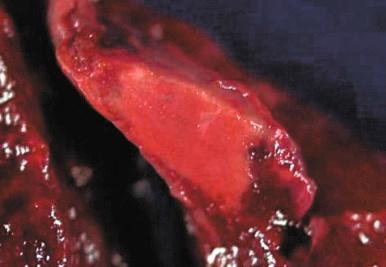
Intervillous thrombi (IVTs) are dark red masses, often with white laminations, that have smooth, glassy cut surfaces. They represent clotted blood, probably from minute fetal hemorrhages that become rapidly coagulated by maternal clotting factors. Intervillous thrombi displace villi peripherally (see Fig. 31.24 ), often leading to a narrow zone of peripheral villous infarction. IVTs range in size from 1 cm to several centimeters in diameter, can be single or multiple, and, although they may be impressive when extensive or large, are rarely of clinical significance.
As mentioned earlier, these are often located adjacent to the fetal surface of the placenta, usually contiguous with the chorionic plate or large stem villi (see Fig. 31.15A ). Giant chorangiomas (>5 cm) or multiple chorangiomas (chorangiomatosis) can result in fetal hydrops, congestive heart failure, and thrombocytopenia, necessitating preterm delivery lest death ensue.
These are small, smooth-lined structures, usually less than 1 cm in diameter, filled with clear mucinous fluid. Such structures are formed by cystic degeneration of placental septae; septal trophoblasts elaborate the fluid in part. Isolated, small septal cysts are considered insignificant findings; multiple septal and/or membrane pseudocysts may be associated with maternal vascular malperfusion.
Small, tan-white, firm irregularly shaped nodules of fibrin (up to 1–2 cm in size) are relatively common incidental findings in later gestational placentas. They are present beneath the chorionic plate ( Fig. 31.25 ), at the placental margin, and scattered throughout the placental parenchyma.
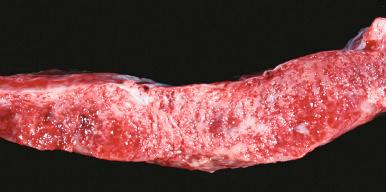
Although excessive fibrin deposition can represent a truly pathologic process associated with fetal growth restriction, stillbirth, and recurrence in future pregnancies, the categorization of placental fibrin as excessive, extensive, or pathologic is subjective. Two general patterns of extensive fibrin deposition have been described.
This is a misnomer because infarction is not present. It is a grossly visible fibrin plaque extending as a rind along the maternal surface; histologically, it consists of extensive fibrin deposits within the decidua and adjacent basal intervillous space.
A gitter infarct, or network of fibrin, now more commonly termed massive perivillous fibrin , consists of diffuse, placental parenchymal infiltration by fibrin. It forms a dense, netlike patchwork of intervillous and perivillous fibrin, occupying a significant percentage of the intervillous space ( Fig. 31.26 ).
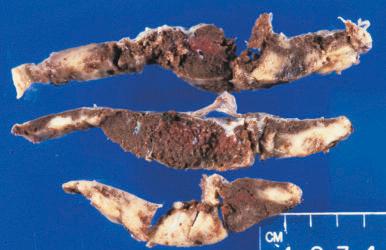
In our experience, not only are these two diagnoses subjective, but they can overlap, probably because they are of related pathogenesis. In addition, in many cases, we have found lesions with a histologic admixture of patterns, including perivillous fibrin deposition, proliferation of extravillous cytotrophoblast, ischemic infarction, chronic villitis, and avascular villi. Although one can often ascribe a primary process, such as perivillous fibrin, to secondary changes, such as those enumerated earlier, sometimes there is no single, satisfactory diagnostic term that fits the picture and for which no single pathogenetic process (e.g., ischemic, immunologic, thrombotic) can be invoked.
A principal goal in examining the twin placenta is establishing zygosity. About 40% of twins are monozygous (identical) and 60% are dizygous (fraternal). A monochorionic placenta is in essence diagnostic of monozygosity; about 30% of twin placentas are monochorionic (2% monoamniotic-monochorionic and 28% diamniotic-monochorionic). Dichorionic twin placentas (70% of twins) can be from a monozygous or dizygous pregnancy; that is, zygosity cannot be determined from a placental examination. Genetic studies of dichorionic gestations have demonstrated that about 85% are dizygous and 15% are monozygous. Other conditions requiring placental examination include twin-twin transfusion syndrome and other complications of multifetal pregnancy.
Careful gross inspection of the twin placenta is an important task for the pathologist with respect to multifetal placental evaluation. A general approach to this is outlined here.
Obstetricians usually mark umbilical cords regarding birth order. One clip typically denotes the first delivered sibling, and an additional clip for each subsequent delivery identifies umbilical cords of the siblings that follow. Parenthetically, when chorioamnionitis is found, in the absence of birth order designation, it usually affects the placenta closest to the endocervical os exclusively or most severely, reflecting that chorioamnionitis represents an ascending infection that reaches the presenting sac before the nonpresenting sac.
Umbilical cord anomalies, particularly of cord insertion, are common in twins and more common than in singletons due to placental disc growths in opposing directions (discussed later). Their approximate prevalence is shown in Table 31.2 .
| Placenta | Marginal Insertion | Membranous Insertion | Single Umbilical Artery |
|---|---|---|---|
| Twin | 10–20 | 5–10 | 2–3 |
| Single | 5 | 1 | 1 |
Separate placental discs indicate dichorionic placentas; these placentas can be assessed as two singleton placentas. There is no need for considering disorders of shared fetal circulations, such as those associated with twin-twin transfusion or twin-reversed arterial perfusion.
Fused discs can be monochorionic or dichorionic. This issue can be resolved by carefully examining the dividing membranes, which are transparent, like cellophane, in monochorionic placentas due to their composition of two amnions only ( Fig. 31.27 ), or they may be thicker and semitranslucent in dichorionic placentas due to two fused chorionic layers between the amnions ( Fig. 31.28 ).
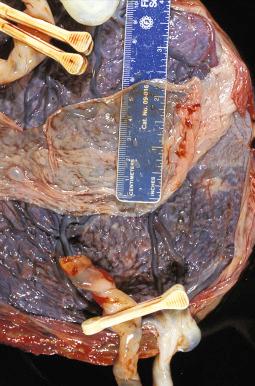
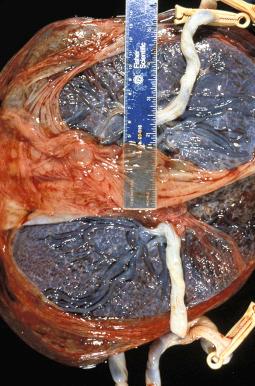
Become a Clinical Tree membership for Full access and enjoy Unlimited articles
If you are a member. Log in here